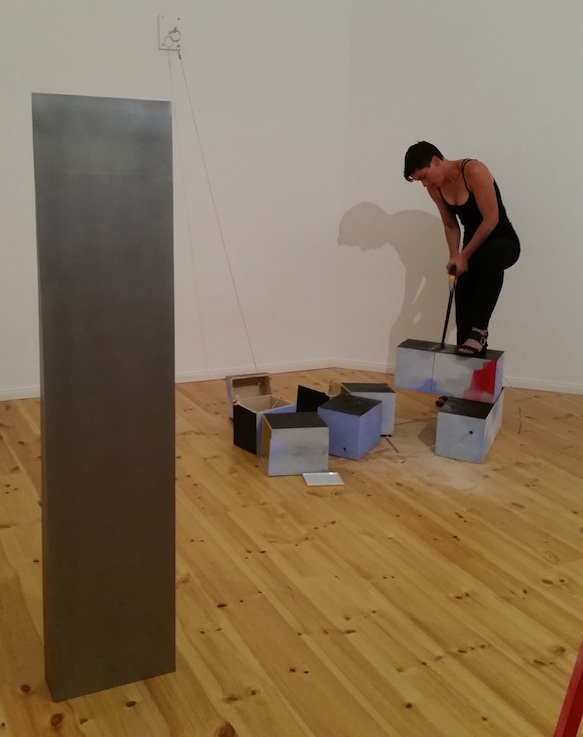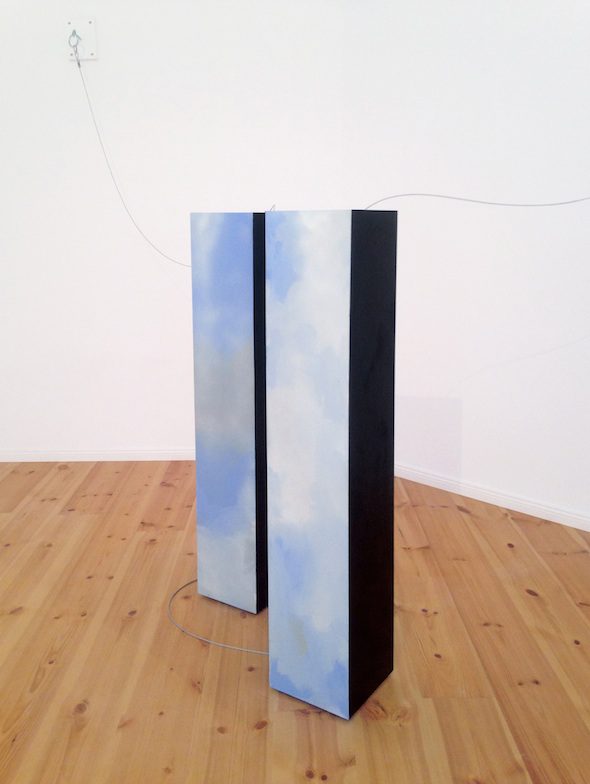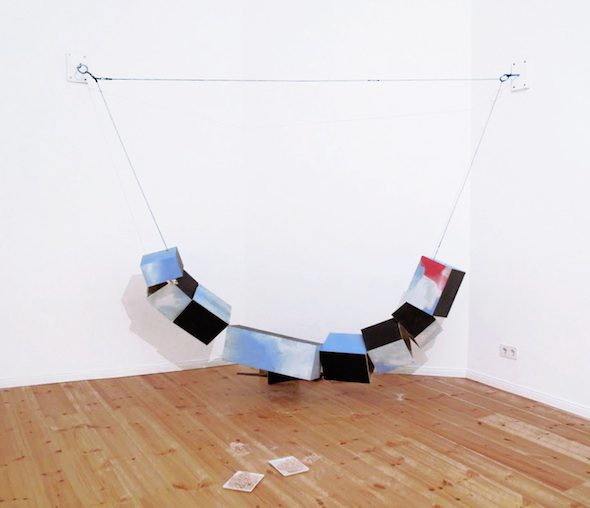Article by William Stewart // Thursday, Sep. 22, 2016
Leah Dixon is strong. She will tell you this, though she doesn’t need to. Her arms show it. She built her own bar, Beverly’s on the Lower East Side of New York, by hand. And if you catch one of her shows, she’s likely to be sawing her artworks into pieces.
Dixon, who holds an MFA from The School of Visual Arts (2014), makes art in a politically informed mode and, since 2012, exclusively in three dimensions. Her choice to privilege three-dimensional forms, whether sculpture or performance, responds to what she perceives as a disjunction between the ever-increasing destruction of bodies and architecture carried out by American domestic and foreign policy, and the overwhelming flattening undergone by that imagery via the media. This constellation of interests—labor, the feminine, politics post 9/11, and a media-saturated America—coalesces across a series of works involving the construction and destruction of twin towers whose proportions directly recall the World Trade Center.

Leah Dixon: ‘Lovers in a Dangerous Time—Necklace’, 2016, Aunt Linda // Courtesy of the artist and Aunt Linda
‘This past June, Dixon participated in the show ‘If the Earth had a flag, the Moon would have to be on it.’ alongside sculptor Mathias Euwer. The show, which included a performance and dinner, was held at the new, semi-private Berlin project space Aunt Linda, organized by Anita Iannacchione and Max Schreier. There, Dixon showed ‘Lovers in a Dangerous Time—Necklace’ (2016). Like the other works in her 9/11 cosmos, it began as two towers, this time attached to the wall by a steel cable threaded to two large rings. During dinner, without warning the guests, she got up, took a hand saw, and systematically disassembled the towers into pieces. The dinner guests, meanwhile, were enacting destruction in their own right. They had each received large clay dumplings with prepared vegetables baked inside and been instructed to smash them open. The guests and the sculptures shared a moment of violence and an awareness of fragility
The title, ‘Lovers in a Dangerous Time’, nods to Canadian musician Bruce Cockburn and the certain brand of 80s pop-music-cum-coded-activism he produced—specifically the song of the same name. Recent travels to Nicaragua as part of an artistic collaboration sparked Dixon’s love of Cockburn, who himself spent time in Latin America during the 1980s, writing songs about his heartbreak over the genocides taking place there. Dixon’s citation of ‘Lovers in a Dangerous Time’ follows a long tradition of the song’s political flexibility, having also served as a euphemism for the heights of the Cold War and the HIV/AIDS crisis. In Dixon’s case, projecting onto the song a poetic valence with the 9/11 attacks and the spectacle that followed was an obvious appropriation, given the lyrics: ‘one day you’re waiting for the sky to fall / the next you’re dazzled by the beauty of it all’. The sense of paradox in Cockburn’s lyric matches the complexity with which Dixon approaches the totem of the Twin Towers, a complexity that brings her back to the song’s title. ‘I see the Twin Towers as a perfect stand-in for two lovers. There is something innately human about them. Maybe they are the world’s most iconic couple for their era.’
I spoke with Dixon recently about her work, the show at Aunt Linda, and why it was so important for her to break a sweat in the middle of the dinner.

Leah Dixon: ‘Lovers in a Dangerous Time—Necklace’, 2016, Aunt Linda // Courtesy of the artist and Aunt Linda
William Stewart: Your sculptures and performances are striking (most immediately) in terms of their materiality. Where does your interest in this come from?
Leah Dixon: For the past five years I’ve been working almost completely in sculpture and performance—very intentionally spatial modes. This was spurred on by an interest in or perhaps obsession with the way that United States foreign policy seems to have no other vocabulary but the destruction of architecture and the human body. These are moments where architecture and bodies fail or crumble, almost always the result of human hands. At the same time, this very physical destruction is mediated through news outlets, through images and video. There’s a kind of a flattening in both a figurative and literal sense that happens with this mediation, and it’s completely dishonest.
I felt that the only way that I could even begin to investigate this issue was through physical, structural, and spatial thinking. I wanted to break away from anything like a screen or a monitor. The more physical I was about my work, the more honest I felt, the clearer things became for me. Sculpture, specifically very direct and physically laborious sculpture, became a way to have a conceptual agency inside of this completely overwhelming socio-political moment.
WS: In addressing this, you’ve chosen as a recurring motif the World Trade Center’s Twin Towers. That’s a very loaded symbol. What is it about the Towers that you find so captivating?
LD: Again, it’s this flattening of architecture and the human body. When they fell, the Twin Towers were like a gestural flattening of human society, structure, bodies, earth, even the sky, which itself all of a sudden became like a two-dimensional backdrop lacking a piece of scenery.
The Towers are fascinating because of the highly emotional nature of their content as well as the ways that that content, both as image and as idea, is susceptible to manipulation. My consumption of the imagery of the falling Towers was pivotal in shaping my own political imagination—as it was for anyone who was even paying minimal attention in the decade following 9/11. It seems to me like the attacks on the World Trade Center resonate with America’s love of consuming anything sweetened by nostalgia, even more by a nostalgia mixed with the toxicity of lazy or reductive political thinking, in part because that’s a perfect cocktail to squelch critical thought. For me, though, it’s also a lesson about the fallibility of architecture. The Towers demonstrated for me the degree to which that fallibility is a very real narrator of human experience.
I began to wonder: was it possible to take this literally monumental structural idea—one that is not only integral to a terrible, violent narrative, but also actively produced by an enormous media complex that both flattens the event into image and blows it out into spectacle—and bring it back down to a human scale? Was there an artistic agency to be found here, a way to move the conversation? Was there a way to build empathy?
WS: And so what sort of poetic or artistic agency were you able to recover?
LD: It’s one that centers on hand-craftsmanship, the human scale, and a certain playfulness. In 2014, I built two wooden towers, each one exactly 5’9.5”, my body height. Over an eight-hour durational performance, I sawed them by hand into joints and chunks and then rebuilt them into two legs in a running position. This performance became a kind of model for me. I continued building towers, which I would then deconstruct into games or furniture. It is important to me that these new towers are always interactive and playful in some way, because I feel that this gives agency to those inside of this continuing story, an agency devoid of nostalgia or consumerist or political emotional directives.

Leah Dixon: ‘Lovers in a Dangerous Time—Necklace’, 2016, Aunt Linda // Courtesy of the artist and Aunt Linda
WS: Do you think that this playfulness risks disrespect towards the victims of the attacks?
LD: Of course there’s always a risk that someone would get offended, but I think the dimension of playfulness is a rather subtle and complex one here. Honestly, there has been so much ‘play’ with the Towers on the part of the media and all number of political engines throughout the entire history of the buildings, from their construction to their legacy as a symbol of the 21st century. I’m not ‘playing’ the Towers this way. For me, the playfulness in my work actually derives from a sense of powerlessness toward the way the Towers-as-political-tool has been used for various violent agendas and a desire to respond to that powerlessness. In fact, it’s that use of the towers as political tool that is disrespectful to the victims, not the playfulness inherent to my sculptures.
WS: It’s worth articulating that the moment the Towers become a flattened totem for whatever political agenda is also the moment that the attacks are no longer carried out against individuals but rather against ideologies, which, I suppose, was precisely the intent of the terrorists. But this forgets the fact that the Towers were full of people, of workers, and not just businessmen, but door guards and janitors and technicians. The attack on the Towers was an attack on working people. This crossed my mind (albeit somewhat obliquely) because the show at Aunt Linda involved you doing so much work to your towers.
LD: Well, something common to all of my tower works has been a desire to leave nothing about the piece hidden, and this also includes exposing the labor involved. This was certainly the aim of the first iteration, with eight hours of me constructing the towers and then deconstructing them into legs. This is important for so many different reasons, but I see this making-visible of the labor as a reaction against a certain kind of willful ignorance toward how the finished product got there, whether that is an artwork in a gallery space or the image of the Twin Towers as part of a political statement.
WS: I saw a video of the performance: the sawing was no joke. You were really exerting yourself. There was sawdust all over the floor. It felt like both you and the artwork were being put through the ringer. You even used one tower as a saw horse for the other.
LD: Yeah, and everyone in the room was completely silent, just watching. The only noise was the very, very loud sound of me sawing and running out of breath. The steel cord was still threaded through the pieces, so the chunks of the towers stayed sequentially connected. It took me about twenty minutes of non-stop sawing. At the end, I collected the sawdust into two piles on the floor and then hoisted the tower-chunks up off the ground with the cable, connecting the cable’s two ends together. The two towers that had each been self-contained and sitting on the floor, were now de-constructed and turned into a giant architectural necklace.
WS: The Italian theorist Maurizio Lazzarato has written about ‘immaterial labor’, which has more or less taken over in the Western neoliberal globalized economy of the second half of the 20th century. Traditional ideas about a factory workforce that bangs around widgets disappeared and, in its place, intellectual labor became subject to the logic of capitalist production. The art world reflected this change, too, in the affinity of conceptual art for dematerializing its works.
I see Lazzarato’s discussion of immaterial labor as drawing attention to the very real kind of labor that takes place even when the objects being labored upon have no primary material form, but I understand the performance aspects of ‘Necklace’ doing something similar, just in inverted terms. You use an emphasized physicality in your artworks to focus on the process required to produce them. ‘Necklace’ has perhaps less to do with the reinsertion of the material and more to do with making visible the labor.
LD: I certainly think that my work strives to achieve a creative opposition to that kind of art-production model that outsources a large majority of the work. I do everything myself, which has only partly to do with my lacking an economy that would allow me to have a big studio. I just find it uninteresting. The moment that I don’t know how my own works came to be, I feel like I’m guilty of the same hypocrisy that I’m criticizing. This is why I make the towers out of wood: because I can make it myself in my studio and I can destroy it myself in the performance. My labor becomes a symbol of my agency over the creation. In as much as the audience needs to be confronted with a de-mystification of the art object or the political object or the media object, perhaps the artist needs a reminder to de-fetishize or de-nostalgize her own thinking about the work she is doing.










